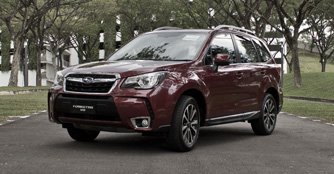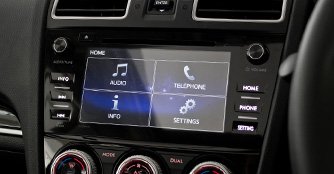Subaru Forester 2.0 XT (A) Facelift Review
27 May 2016|96,379 views
Crossover Sports Utility Vehicles (SUVs) are all the rage these days. And you know what? We get it. Fuel efficiency, cabin comfort and quality, and overall practicality trumps performance, especially in a place like Singapore where the roads aren't empty or long enough for performance to really matter.
It's no surprise, then, that most manufacturers have gotten in on the action. The Japanese contingent includes the Honda CR-V, the Mazda CX-5 and the Toyota RAV4, the Germans boast the BMW X3, the Mercedes-Benz GLC and the Volkswagen Tiguan, while the Koreans have the Kia Sportage. But you would be mistaken to think that crossovers are just a recently emerging trend.
It's fair to say that the Subaru Forester is the 'OG' of the crossover world. It first emerged back in 1995 (as the Streega concept), and hit the markets in 1997, way before the term 'crossover SUV' made it into our automotive lexicon.
2014 saw an extensive redesign of the model, with key changes to the Forester XT such as the new X-Mode All-Wheel Drive (AWD) as well as a Continuously Variable Transmission (CVT). Now, Subaru has updated the car for 2016 to keep up with the growing market segment.
Up close and Personal
Two years on from a complete redesign of the model, it's not surprising that changes are on the minimal and subtle side. From the outside, it would be easy to mistake the new car for the old one, and it will take a keen eye to spot the changes.
It's no surprise, then, that most manufacturers have gotten in on the action. The Japanese contingent includes the Honda CR-V, the Mazda CX-5 and the Toyota RAV4, the Germans boast the BMW X3, the Mercedes-Benz GLC and the Volkswagen Tiguan, while the Koreans have the Kia Sportage. But you would be mistaken to think that crossovers are just a recently emerging trend.
It's fair to say that the Subaru Forester is the 'OG' of the crossover world. It first emerged back in 1995 (as the Streega concept), and hit the markets in 1997, way before the term 'crossover SUV' made it into our automotive lexicon.
2014 saw an extensive redesign of the model, with key changes to the Forester XT such as the new X-Mode All-Wheel Drive (AWD) as well as a Continuously Variable Transmission (CVT). Now, Subaru has updated the car for 2016 to keep up with the growing market segment.
Up close and Personal
Two years on from a complete redesign of the model, it's not surprising that changes are on the minimal and subtle side. From the outside, it would be easy to mistake the new car for the old one, and it will take a keen eye to spot the changes.
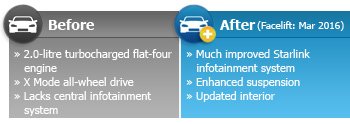 |
Improved exterior features include a new grille and 18-inch rims. The head lights now feature a Steering Response function, which move left or right according to the steering wheel, while the taillights have also been revised a tad.
On the inside, the updated Starlink infotainment system receives a much needed improvement, and proves to be remarkably intuitive and easy to use, even when diving deep into the menus. The steering wheel-mounted buttons have been updated as well, with a simplified layout that makes operation more intuitive. There is also a 440W Harman/Kardon audio system fitted to the car, which performs satisfyingly well.
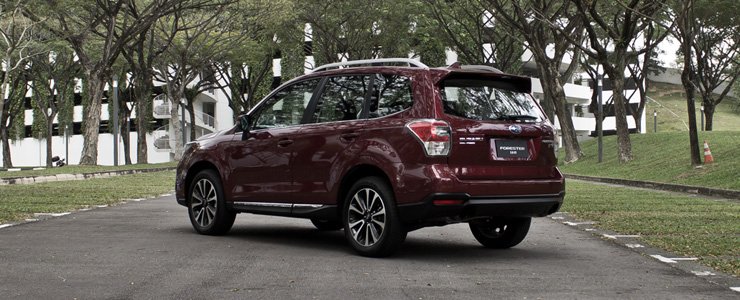 |
The Drive
The key figures here are 237bhp and 350Nm of torque, produced by the Forester XT's turbocharged 2.0-litre horizontally-opposed flat-four engine. While it may be the same engine as the model released back in 2014, it still remains a very engaging and energetic unit.
The Subaru Intelligent Drive (SI Drive) system allows you to choose from three modes that varies the car's power delivery. In full-on Sport Sharp (S#) mode, the transmission offers up to eight gears to select from, which provides more driving involvement that you would think capable from a CVT.

 The SI Drive allows you to pick between three drive modes, and we personally found S# the most engaging
The SI Drive allows you to pick between three drive modes, and we personally found S# the most engaging
The driving position and ride height is high, but for a car its size, it rides very well and feels planted on the road, and is fairly capable around bendy roads. This is made possible thanks to the car's enhanced suspension, with a stiffer front cross member and better coils and dampers. The car feels stiffer than before, and does an excellent job of soaking up imperfections in the road.
It's not the quietest of rides, though. At highway speeds, the Forester lets in a fair bit of wind noise, so we are thankful for the Harmon/Kardon sound system to pump out tunes. Also, the Forester XT is a wee bit of a petrol guzzler, no thanks to turbocharging and AWD. Subaru lists fuel consumption at 11.8km/L, but we struggled to get anywhere close to that.
The key figures here are 237bhp and 350Nm of torque, produced by the Forester XT's turbocharged 2.0-litre horizontally-opposed flat-four engine. While it may be the same engine as the model released back in 2014, it still remains a very engaging and energetic unit.
The Subaru Intelligent Drive (SI Drive) system allows you to choose from three modes that varies the car's power delivery. In full-on Sport Sharp (S#) mode, the transmission offers up to eight gears to select from, which provides more driving involvement that you would think capable from a CVT.

The driving position and ride height is high, but for a car its size, it rides very well and feels planted on the road, and is fairly capable around bendy roads. This is made possible thanks to the car's enhanced suspension, with a stiffer front cross member and better coils and dampers. The car feels stiffer than before, and does an excellent job of soaking up imperfections in the road.
It's not the quietest of rides, though. At highway speeds, the Forester lets in a fair bit of wind noise, so we are thankful for the Harmon/Kardon sound system to pump out tunes. Also, the Forester XT is a wee bit of a petrol guzzler, no thanks to turbocharging and AWD. Subaru lists fuel consumption at 11.8km/L, but we struggled to get anywhere close to that.
Conclusion
The Forester XT is somewhat of an oddity in its segment. With many manufacturers pumping out crossover models that chase fuel economy figures and boast best-in-class features, Subaru takes another route. Instead, what the Forester XT offers is an entirely different proposition - a crossover with genuine performance and all-terrain conquering off-road capabilities.
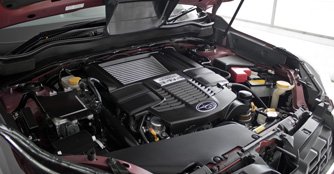
 The turbocharged 2.0-litre is significantly more powerful (90bhp extra) than its naturally aspirated sibling
The turbocharged 2.0-litre is significantly more powerful (90bhp extra) than its naturally aspirated sibling
Of course, the main question is whether or not the turbocharged engine is necessarily better than its naturally aspirated counterpart? Well, the answer would be yes, simply because unlike what we experienced in Thailand, most drivers in Singapore will spend 100 percent of their time on tarmac. The linear power delivery of the naturally aspirated engine would be better equipped for off-road situations, but on tarmac, the turbocharged unit is more powerful and more exciting.
Whether you want to think of it as a wagon on stilts or an SUV on steroids, the Forester XT is no doubt a good, if niche, car, together with all its imperfections. And it's an 'OG', too, which gives it heritage and character. To us, that is more than what can be said for most cars in its segment.
The Forester XT is somewhat of an oddity in its segment. With many manufacturers pumping out crossover models that chase fuel economy figures and boast best-in-class features, Subaru takes another route. Instead, what the Forester XT offers is an entirely different proposition - a crossover with genuine performance and all-terrain conquering off-road capabilities.

Of course, the main question is whether or not the turbocharged engine is necessarily better than its naturally aspirated counterpart? Well, the answer would be yes, simply because unlike what we experienced in Thailand, most drivers in Singapore will spend 100 percent of their time on tarmac. The linear power delivery of the naturally aspirated engine would be better equipped for off-road situations, but on tarmac, the turbocharged unit is more powerful and more exciting.
Whether you want to think of it as a wagon on stilts or an SUV on steroids, the Forester XT is no doubt a good, if niche, car, together with all its imperfections. And it's an 'OG', too, which gives it heritage and character. To us, that is more than what can be said for most cars in its segment.
Crossover Sports Utility Vehicles (SUVs) are all the rage these days. And you know what? We get it. Fuel efficiency, cabin comfort and quality, and overall practicality trumps performance, especially in a place like Singapore where the roads aren't empty or long enough for performance to really matter.
It's no surprise, then, that most manufacturers have gotten in on the action. The Japanese contingent includes the Honda CR-V, the Mazda CX-5 and the Toyota RAV4, the Germans boast the BMW X3, the Mercedes-Benz GLC and the Volkswagen Tiguan, while the Koreans have the Kia Sportage. But you would be mistaken to think that crossovers are just a recently emerging trend.
It's fair to say that the Subaru Forester is the 'OG' of the crossover world. It first emerged back in 1995 (as the Streega concept), and hit the markets in 1997, way before the term 'crossover SUV' made it into our automotive lexicon.
2014 saw an extensive redesign of the model, with key changes to the Forester XT such as the new X-Mode All-Wheel Drive (AWD) as well as a Continuously Variable Transmission (CVT). Now, Subaru has updated the car for 2016 to keep up with the growing market segment.Up close and Personal
Two years on from a complete redesign of the model, it's not surprising that changes are on the minimal and subtle side. From the outside, it would be easy to mistake the new car for the old one, and it will take a keen eye to spot the changes.
It's no surprise, then, that most manufacturers have gotten in on the action. The Japanese contingent includes the Honda CR-V, the Mazda CX-5 and the Toyota RAV4, the Germans boast the BMW X3, the Mercedes-Benz GLC and the Volkswagen Tiguan, while the Koreans have the Kia Sportage. But you would be mistaken to think that crossovers are just a recently emerging trend.
It's fair to say that the Subaru Forester is the 'OG' of the crossover world. It first emerged back in 1995 (as the Streega concept), and hit the markets in 1997, way before the term 'crossover SUV' made it into our automotive lexicon.
2014 saw an extensive redesign of the model, with key changes to the Forester XT such as the new X-Mode All-Wheel Drive (AWD) as well as a Continuously Variable Transmission (CVT). Now, Subaru has updated the car for 2016 to keep up with the growing market segment.Up close and Personal
Two years on from a complete redesign of the model, it's not surprising that changes are on the minimal and subtle side. From the outside, it would be easy to mistake the new car for the old one, and it will take a keen eye to spot the changes.
Improved exterior features include a new grille and 18-inch rims. The head lights now feature a Steering Response function, which move left or right according to the steering wheel, while the taillights have also been revised a tad.
On the inside, the updated Starlink infotainment system receives a much needed improvement, and proves to be remarkably intuitive and easy to use, even when diving deep into the menus. The steering wheel-mounted buttons have been updated as well, with a simplified layout that makes operation more intuitive. There is also a 440W Harman/Kardon audio system fitted to the car, which performs satisfyingly well.
On the inside, the updated Starlink infotainment system receives a much needed improvement, and proves to be remarkably intuitive and easy to use, even when diving deep into the menus. The steering wheel-mounted buttons have been updated as well, with a simplified layout that makes operation more intuitive. There is also a 440W Harman/Kardon audio system fitted to the car, which performs satisfyingly well.
The Drive
The key figures here are 237bhp and 350Nm of torque, produced by the Forester XT's turbocharged 2.0-litre horizontally-opposed flat-four engine. While it may be the same engine as the model released back in 2014, it still remains a very engaging and energetic unit.
The Subaru Intelligent Drive (SI Drive) system allows you to choose from three modes that varies the car's power delivery. In full-on Sport Sharp (S#) mode, the transmission offers up to eight gears to select from, which provides more driving involvement that you would think capable from a CVT.
The driving position and ride height is high, but for a car its size, it rides very well and feels planted on the road, and is fairly capable around bendy roads. This is made possible thanks to the car's enhanced suspension, with a stiffer front cross member and better coils and dampers. The car feels stiffer than before, and does an excellent job of soaking up imperfections in the road.
It's not the quietest of rides, though. At highway speeds, the Forester lets in a fair bit of wind noise, so we are thankful for the Harmon/Kardon sound system to pump out tunes. Also, the Forester XT is a wee bit of a petrol guzzler, no thanks to turbocharging and AWD. Subaru lists fuel consumption at 11.8km/L, but we struggled to get anywhere close to that.
The key figures here are 237bhp and 350Nm of torque, produced by the Forester XT's turbocharged 2.0-litre horizontally-opposed flat-four engine. While it may be the same engine as the model released back in 2014, it still remains a very engaging and energetic unit.
The Subaru Intelligent Drive (SI Drive) system allows you to choose from three modes that varies the car's power delivery. In full-on Sport Sharp (S#) mode, the transmission offers up to eight gears to select from, which provides more driving involvement that you would think capable from a CVT.
The driving position and ride height is high, but for a car its size, it rides very well and feels planted on the road, and is fairly capable around bendy roads. This is made possible thanks to the car's enhanced suspension, with a stiffer front cross member and better coils and dampers. The car feels stiffer than before, and does an excellent job of soaking up imperfections in the road.
It's not the quietest of rides, though. At highway speeds, the Forester lets in a fair bit of wind noise, so we are thankful for the Harmon/Kardon sound system to pump out tunes. Also, the Forester XT is a wee bit of a petrol guzzler, no thanks to turbocharging and AWD. Subaru lists fuel consumption at 11.8km/L, but we struggled to get anywhere close to that.
Conclusion
The Forester XT is somewhat of an oddity in its segment. With many manufacturers pumping out crossover models that chase fuel economy figures and boast best-in-class features, Subaru takes another route. Instead, what the Forester XT offers is an entirely different proposition - a crossover with genuine performance and all-terrain conquering off-road capabilities.
Of course, the main question is whether or not the turbocharged engine is necessarily better than its naturally aspirated counterpart? Well, the answer would be yes, simply because unlike what we experienced in Thailand, most drivers in Singapore will spend 100 percent of their time on tarmac. The linear power delivery of the naturally aspirated engine would be better equipped for off-road situations, but on tarmac, the turbocharged unit is more powerful and more exciting.
Whether you want to think of it as a wagon on stilts or an SUV on steroids, the Forester XT is no doubt a good, if niche, car, together with all its imperfections. And it's an 'OG', too, which gives it heritage and character. To us, that is more than what can be said for most cars in its segment.
Also read our comparison article on:
Nissan X-Trail 2.0 Premium 7-seater (A) vs Subaru Forester 2.0i-L (A)Car Information
Subaru Forester 2.0 XT (A)
CAT B|Petrol|11.8km/L
Horsepower
177kW (238 bhp)
Torque
350 Nm
Acceleration
7.5sec (0-100km /hr)
This model is no longer being sold by local distributor
All Used Subaru ForesterThank You For Your Subscription.
























